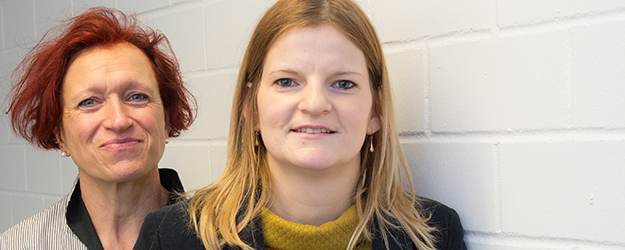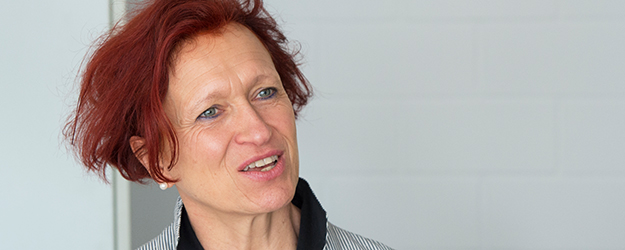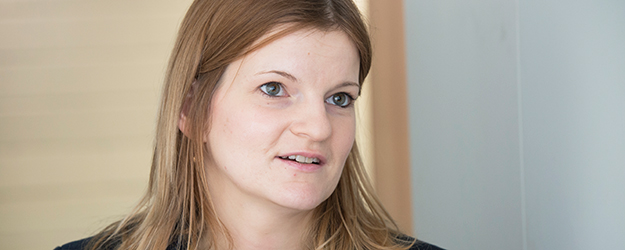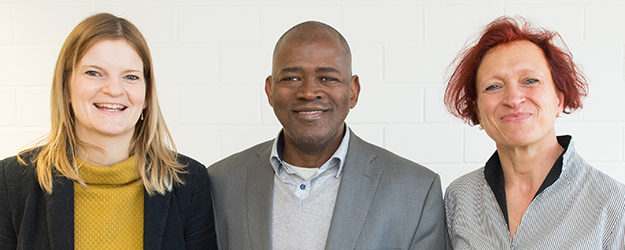4 April 2019
The Department of Anthropology and African Studies of Johannes Gutenberg University Mainz (JGU) and the Institute of African Studies of Goethe University Frankfurt initiated the joint pilot project "Africans in the Rhine-Main Region" in early 2019. It is dedicated to the currently hot sociopolitical issue of linguistic integration. The Rhine-Main Universities (RMU) Initiative Funding for Research finances this partnership undertaking.
Dr. Klaudia Dombrowsky-Hahn has only just moved into her office at the Institute of African Studies at Goethe University. But a lot has already happened in the run-up phase. "Our project started already in January," she points out. She and her colleague Dr. Sabine Littig of JGU's Department of Anthropology and African Studies (ifeas) have already been out and about in Frankfurt and visited, among other things, so-called Afro Shops, of which there are many located in the vicinity around the city's main rail station.
"Normally we travel to Africa to do research there," says Dombrowsky-Hahn. "But now we are bringing our research home." "It's a real pilot project, there has never been anything comparable before," adds Littig. "So we really don’t know what the outcome will be." The research team wants to approach the subject of African studies or – to be more accurate – African linguistics from a new angle.
Multilingualism in Africa
The spotlight here is on aspects of linguistic integration, on determining how immigrants whose parents or who themselves came from Africa learn the German language. What strategies do they employ for this purpose? What does it mean for these Africans in Germany to acquire a new language and what happens to their native tongue? The "Africans in the Rhine-Main region" project intends to find answers to all these questions. For the first two years, the Rhine-Main Universities' (RMU) Initiative Funding for Research will finance the joint undertaking. Mainz University, Goethe University Frankfurt, and Technische Universität Darmstadt formed the strategic RMU alliance back in 2015 and initiated collaborative projects at the departmental and subject level, such as the African Studies Rhine-Main network. The purpose of the RMU Initiative Funding for Research is to promote the integration of research being undertaken at the three universities.
In Frankfurt, Professor Axel Fleisch is in charge of the project, in Mainz it is Junior Professor Nico Nassenstein. Implementation lies primarily in the hands of Littig and Dombrowsky-Hahn. "We will have the support of an additional assistant who will be a student based at JGU in the first year and at Goethe University in the second," explains Littig.
Most Germans grow up monolingual and generally only learn other languages at school. This is completely different in Africa. "Most African people have a command of several languages," says Dombrowsky-Hahn. "It is mainly because of their mobility that they become exposed to other languages. They move somewhere new, perhaps to live with a spouse, and have to deal with what is for them a foreign language. And even the children grow up able to speak several languages. They do not consider there is anything special about learning a new language. Indeed, it is claimed that they only need about a month before they feel comfortable with a different language."
What is interesting is the fact that they do not learn the language in the classroom, but through day-to-day interaction with other people. "In Africa, people place great emphasis on communicating with each other," states Dombrowsky-Hahn. "Here in Frankfurt, you board the subway, you sit down amongst strangers – and you don't utter a word. That would be unimaginable in Africa. There are lively conversations between passengers on every bus trip."
Personal language profiles
Both of the linguists are interested in this mode of informal learning that is clearly a very effective strategy. "In a second phase of our project, we can well imagine working with specialists dealing with the subject of German as a Foreign Language," indicates Littig. "We are also asking about how people actually learn," adds Dombrowsky-Hahn. "We hope that this may lead to the generation of concepts on how we can improve German courses and facilitate the acquisition of new languages."
But first the two need to get in touch with Africans living in the Rhine-Main region and persuade them to cooperate with them. Littig is optimistic since they have made a good number of contacts already. "There are African communities we can approach. In Rhineland-Palatinate we have a very active Ruanda Association that might help us while at our universities there are many students who come from Africa or have African roots." In addition, she has already found potential study participants with the help of social media. "We are thrilled about anyone who contacts us."
A whole range of methods will be used to explore the concept of language acquisition. This will include questionnaires, participative observation as a standard technique employed in anthropology and African studies – perhaps in the Afro Shop around the corner – as well as detailed interviews. "As a starting point, we decided to adopt the approach developed by the Vienna linguist Brigitta Busch," says Littig and shows a page with a silhouette image of a person holding up their hand in greeting. "We use this to create personal language profiles. Our subjects are asked to assign a particular color to each language they speak and then position that color somewhere on the body." The result is a surprisingly comprehensive and complete profile of an individual's language repertoire.
One the first study subjects of the project has his office around the corner from here. Linguist Professor Abdourahmane Diallo from Guinea demonstrates how the diagram works: After some thought, he selects the color green for Fula, his native language, which he then locates close to the heart. He then continues for each of his languages. As the language of law and religion, he puts classic Arabic and Moroccan Arabic in the head area. He assigns to the right hand his working languages of French, English, and German, while Greek, Swahili, and a few other African languages are positioned on the greeting left hand. At the end he says: "Actually, I know some more languages, but haven't put them in because I don't currently speak them."
Ice-blue for German, English on the feet
"In this way we learn much about the emotions and functions associated with the relevant languages," concludes Littig. "For example, we had someone who assigned the English language to his feet because that is the language he uses when traveling." German was perceived in a variety of different ways. "One person saw it in terms of the color yellow because she considers it be very warm. Another chose ice-blue because of the clarity of the language."
The "Africans in the Rhine-Main region" project has only just commenced. Dombrowsky-Hahn and Littig are working hard to make sure it is a success. Of course, they cannot yet predict what sort of results they will achieve, but they can fall back on their experience as linguists: "At the beginning, we intend to concentrate primarily on people from West and Central Africa," explains Littig. "This is simply because we are most familiar with those areas and their languages. But it is quite conceivable that we will subsequently recruit other colleagues for the project who are knowledgeable about other regions."
The two hope to gain valuable insights into a subject that has been at the center of attention both publicly and in the media for some years. Linguistic integration is a core concern at a time in which many people are being forced to flee their homelands and seek protection in Europe. "All of us here had already been thinking about a project of this kind,” sums up Dombrowsky-Hahn, "but now we have the opportunity to finally make it happen."





